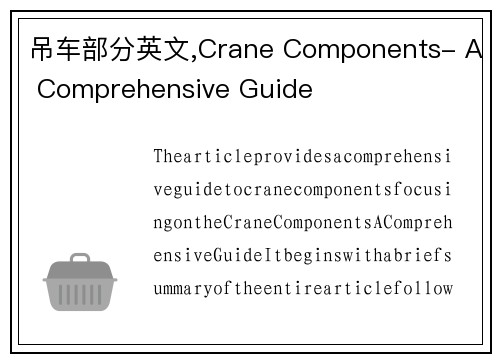精品项目
吊车部分英文,Crane Components- A Comprehensive Guide
吊车部分英文,Crane Components- A Comprehensive Guide
The article provides a comprehensive guide to crane components, focusing on the Crane Components- A Comprehensive Guide. It begins with a brief summary of the entire article, followed by a detailed discussion of six aspects related to crane components. These aspects include the types of crane components, their functions, common materials used, maintenance and inspection procedures, safety considerations, and advancements in crane component technology. The article concludes with a summary and synthesis of the information presented in the Crane Components- A Comprehensive Guide.
Types of Crane Components
Crane components can be categorized into several types based on their specific functions. The main types include the boom, hoist, trolley, hook, outriggers, and controls. Each component plays a crucial role in the operation of a crane and contributes to its overall functionality. The boom provides the lifting capability, while the hoist enables vertical movement. The trolley allows horizontal movement, and the hook is responsible for attaching and securing the load. Outriggers provide stability, and controls facilitate the operation of the crane.
Functions of Crane Components
Each crane component has a specific function that contributes to the overall operation of the crane. The boom extends and retracts to reach different heights and distances. The hoist lifts and lowers the load. The trolley moves the load horizontally along the boom. The hook securely holds the load in place. Outriggers stabilize the crane during lifting operations. Controls allow the operator to maneuver and control the crane's movements. Understanding these functions is essential for safe and efficient crane operation.

Common Materials Used
Crane components are typically made from high-strength materials to withstand heavy loads and harsh operating conditions. Common materials used include steel, aluminum, and various alloys. Steel is widely used due to its strength and durability, while aluminum is favored for its lightweight properties. Alloys are often used to enhance specific characteristics such as corrosion resistance or superior strength-to-weight ratio. The choice of materials depends on the specific component and its intended use.
Maintenance and Inspection Procedures
Regular maintenance and inspection of crane components are vital to ensure their safe and reliable operation. Maintenance procedures include lubrication, cleaning, and regular checks for wear and tear. Inspection procedures involve thorough visual inspections, non-destructive testing, and load testing. Regular maintenance and inspections help identify potential issues before they become safety hazards and extend the lifespan of crane components.
Safety Considerations
Safety is of utmost importance when working with cranes. Crane components must be properly maintained, inspected, and operated to prevent accidents and injuries. Safety considerations include proper training for operators, adherence to load capacity limits, use of appropriate personal protective equipment, and adherence to safety protocols. Safety devices such as limit switches, emergency stop buttons, and overload protection systems are also critical in ensuring safe crane operations.
Advancements in Crane Component Technology
Advancements in technology have led to significant improvements in crane components. These advancements include the use of advanced materials, such as carbon fiber composites, for increased strength and reduced weight. Electronic controls and sensors enhance precision and safety during crane operations. Automation and remote control capabilities improve efficiency and reduce the need for human intervention. These advancements continue to shape the future of crane component technology, making cranes safer and more efficient.
FUN乐天堂In conclusion, crane components play a crucial role in the operation of cranes. Understanding the types, functions, materials, maintenance procedures, safety considerations, and advancements in crane component technology is essential for safe and efficient crane operations. The Crane Components- A Comprehensive Guide provides a comprehensive overview of these aspects, serving as a valuable resource for crane operators, technicians, and enthusiasts.
